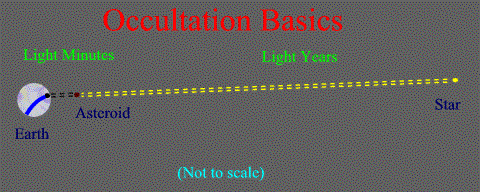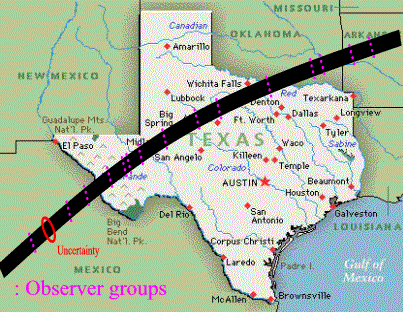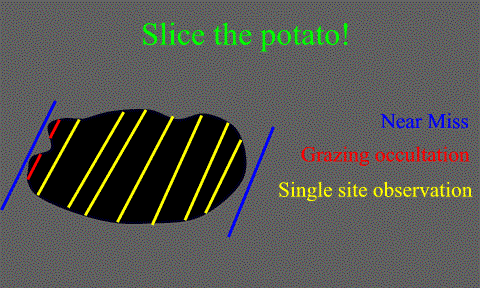Occultation Primer
Occultation = When a dark object (usually an
asteroid or the moon) moves in front of (eclipses) a brighter
object (a star or planet), dimming or completely blocking the
brighter object's light.
There are several major categories:
 |
Asteroids occulting stars. These are the most
common events recorded. (Remember there are thousands
of asteroids and millions of stars.) Thanks to a great
variety in the geometry plus the relative sizes and
magnitudes, these events are very variable in duration and
observability.
|
 |
The moon occults stars or planets. A total
lunar occultation means the moon totally covers the star or
planet. These are often long events. A grazing
occultation means the object skims one limb (edge) of the
moon and will wink in & out as it passes mountains and
valleys.
|
 |
Planets occult stars. These are not commonly
recorded, thanks to the brightness of most of the
planets. (This makes it hard to see the star behind
it, unless the star is very bright.) Since the planets
move slowly and are fairly large, these are often long
events.
|
 |
Planet's moons occult stars. Most often, the
events are for Jupiter's four bright moons. Since the
moons appear to move rather swiftly, these are often fast
events.
|
 |
Jupiter's moons in "mutual events".
Every six years, Jupiter's moons' orbits line up with the
Earth, so we see one moon cover another or one passes over
the shadow spot of another. (We're in that period now -
Winter of 2002-3.)
|
The facts behind occultations are both easy to
understand and mind-boggling:

 |
An occultation involves objects many light years apart, one
a very small (somewhat) dark disk, one a (somewhat) bright
point, and a line of locations on a sphere (Earth) coming
into very precise alignment for a few brief seconds.
|
 |
The star's positions are (practically) fixed and very
accurately known. Most are point sources of light which
won't show as a disk under high magnification. This
makes an ideal detector:
 |
Asteroids & airless moons - it will suddenly
blink off and back on
|
 |
Very close, very large stars can sometimes produce a
stepped event where the star gradually disappears
rather than winking on or off.
|
 |
Planets and moons with an atmosphere will also dim
gradually
|
|
 |
Planets and larger asteroids will resolve into a disk, even
with relatively small scopes. Smaller asteroids and
Jupiter's moons may not resolve into disks with amateur
scopes, but are still large enough to occult the star.
|
 |
The distances can be mind boggling:
 |
Blocking bodies are relatively near - The moon is light-seconds
away, while asteroids and planets can be light-
minutes or hours away.
|
 |
The stars are dozens to thousands of light years
away. (That's why such large objects appear as
points of light rather than disks or spheres.)
|
|
 |
Like an eclipse, the "shadow" of the star follows
a curved path on the surface of the Earth.
 |
Most occultation paths will have either the start or
end point on Earth's surface.
|
 |
The path's curve is affected by the blocking
object's and Earth's rotation and orbit.
|
 |
The size, shape, orbit and spin of the blocking body
are used to determine the path's size and
shape. Since many asteroids are not well
studied, approximations of these numbers are used,
which can mean a 25-50% error in the path location
& size!
|
 |
Most events move very swiftly across the Earth - The
shadow can travel thousands of miles across the
Earth in only a few seconds.
|
|

 |
To gather useful observations, groups of observers place
themselves along the path in a perpendicular slice of that
path (see the dots on the map above):
 |
The prediction gives both a center line (maximum
eclipse time) and shadow width (minimum eclipse time
or near-miss).
|
 |
Ideally, groups would assign people along the
center, out to the edge of the shadow, and just
outside the predicted path to give full coverage.
|
 |
Each person within a group would observe a slightly
different profile of the blocking body. For a
50km-wide path, observers spaced 7-10km apart would
give useful profiles.
|
 |
Multiple group can help fully define the shape by
placing observers in slightly different slices of
the asteroid to increase the definition of the
profile (see below).
|
 |
Even a near miss would help define the maximum
size. Grazing occultations would show the
profile in detail.
|
 |
Each observation is like slicing a potato into
chips. Stacking the chips then gives us a
rough shape for the potato.
|
|

How do we time occultations?
 |
Visual observations are the easiest, but least accurate
method. You'll need a telescope able to view the star
in question, a short wave radio tuned to 5, 10, 15, or 20
MHz (WWV), a tape recorder, and a finder chart for the
event.
 |
Finder charts and event info can be found at http://lunar-occultations.com/iota/iotandx.htm
|
 |
Tune the radio to WWV and set the volume so the tape
recorder can record it and your voice.
|
 |
Use the finder chart and set the scope to center on
the star.
|
 |
When the star winks out, call "out".
When the star reappears, call "in".
|
 |
A clicker of some sort would help increase the
accuracy of the timing by producing a quicker sound.
|
 |
Ensure the timing ticks from WWV are recorded both
before and after the event.
|
|
 |
Video recording is much more accurate and eliminates human
error in calling out the timing. Unless you're using a
large telescope, video setups are not capable of recording
very faint events.
 |
Lunar occultations of bright stars or planets can be
recorded with a camcorder zoomed to maximum. A
radio playing WWV will be recorded through the
camcorder's microphone.
|
 |
Video recording of fainter events requires a low
light security camera attached to the eyepiece of a
telescope. A camcorder records the video from
the camera and the audio from the radio playing WWV.
See http://lunar-occultations.com/iota/video/rnvideosetup.htm
for more information on this type of setup.
|
|
What do we need?
 |
Objects:
 |
The star's position to arc seconds accuracy
|
 |
The time to hundredths of a second
|
 |
The observer's position in latitude and longitude to
within 10
|
|
 |
Equipment for visual recording:
 |
Telescope - 4-8 inches, f/6 or wider
|
 |
Tape recorder with microphone
|
 |
Short-wave radio tuned to WWV (5, 10, 15, or 20 MHz)
|
 |
Charts and information about the occultation
|
|
What does it tell us?
 |
At the most basic, the star helps outline the blocking
object. This will define:
 |
The orbit, size, and shape of the blocking object
|
 |
The mountain and valley profile of the moon (during
a grazing occultation)
|
 |
Small moonlets of asteroids
|
 |
Close companion stars that can't be split any other
way
|
 |
Redefine the star's position
|
|
 |
If the dark object is airless, the occultation appears like
switching off a light.
|
 |
If the dark object has an atmosphere, the occultation is
likely to dim or change, then wink out, then reappear dim
and then come back to the original magnitude.
Sometimes, scientists can read the change in the light
spectrum and determine the gasses in the atmosphere.
Most of the time, this can help define the depth of the
atmosphere.
|
Why volunteer?
 |
Occultations happen randomly throughout the surface of the
Earth. Some will happen in your neighborhood and your
backyard.
|
 |
Professional astronomers are collected at large
observatories (Hawaii, Chile, the Rockies, & sites in
Europe & Japan) or at universities. They or their
equipment are likely to be too busy to observe
occultations. Their equipment may not be suitable for
occultation observations.
|
 |
Amateur astronomers are scattered around the world and have
equipment suitable to occultation observation.
|
 |
Amateurs are also willing to donate time and effort to the
project.
|
 |
The observations return valuable information to expand our
scientific knowledge.
|
 |
This knowledge may help scientists defend the Earth from
encroaching asteriods!
|
|
|
|